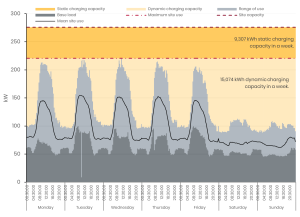2. Load management
Upgrade your EV charging with advanced load management. Compare static for even power distribution with dynamic for maximum power usage.
What is load management?
Advanced load management systems help sites with limited electrical supply capacity operate charging infrastructure more effectively. They distribute the total power available across the individual charge points in use.
If you have:
- a vehicle that requires a quick top-up charge during shifts; and
- a vehicle that requires a slow charge overnight at the end of a shift;
you could benefit from implementing load management systems. These systems will also allow you to avoid costly upgrades to your electrical supply.
It is also important to think about the potential growth of your BEV fleet, as installing flexible load management systems earlier can reduce the need for infrastructure upgrades later.
Static load management systems
A standard or static load management system will evenly distribute a set power to all charge points based on the unused static capacity available (represented by the dark yellow in the figure below).
No matter how many vehicles are charging, every charging station will be allocated power at its rated capacity from the available static supply. For example, a 7.4kW charge point won’t get more than 7.4kW of power.
You cannot exceed your static capacity. Doing so will overload your site’s circuits, leading to power outages. However, if power demand at your site varies throughout the day and the week (see the graph below), it’s likely you won’t be fully using the extra power that becomes available when energy usage falls. The light-yellow colour in graph below shows the energy not used with static load management.

Dynamic load management systems
A dynamic load management system enables you to use the maximum power available at any time.
When your site’s energy demand falls, more energy becomes available for charging vehicles. With a dynamic load management system in place, you could make use of this extra capacity by installing more chargepoints or chargepoints with a higher power rating.
These charge points can also be integrated with more functionality, including:
- remote control of charge points;
- allowing ending or prioritising vehicle charging sessions; or
- monitoring the usage of charging infrastructure at a site over time.
User apps and radio frequency ID (RFID) cards can be monitored through the charging system to track each vehicle’s electricity usage. Coupling this with other vehicle usage data – if available – can determine how efficiently vehicles are being driven.